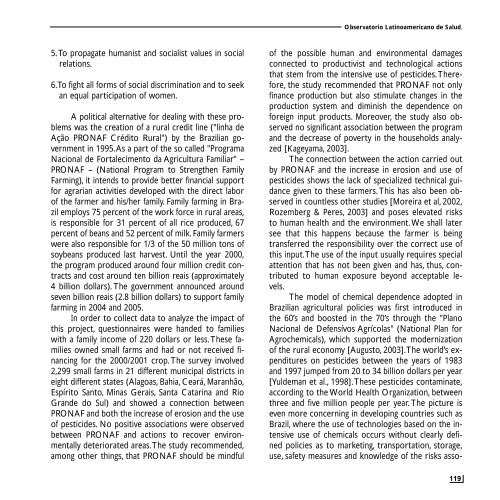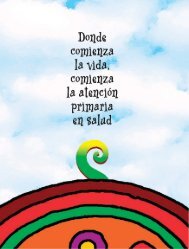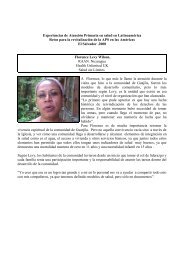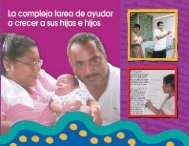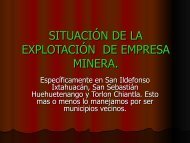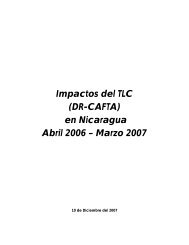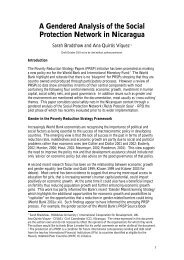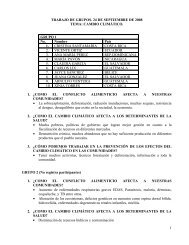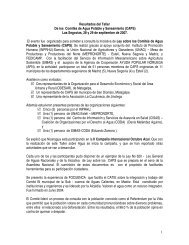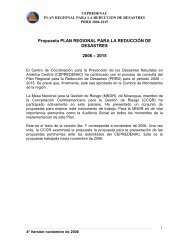Download - CISAS | Centro de Información y Servicios de AsesorÃa ...
Download - CISAS | Centro de Información y Servicios de AsesorÃa ...
Download - CISAS | Centro de Información y Servicios de AsesorÃa ...
Create successful ePaper yourself
Turn your PDF publications into a flip-book with our unique Google optimized e-Paper software.
Observatorio Latinoamericano <strong>de</strong> Salud.5.To propagate humanist and socialist values in socialrelations.6.To fight all forms of social discrimination and to seekan equal participation of women.A political alternative for <strong>de</strong>aling with these problemswas the creation of a rural credit line ("linha <strong>de</strong>Ação PRONAF Crédito Rural") by the Brazilian governmentin 1995.As a part of the so called "ProgramaNacional <strong>de</strong> Fortalecimento da Agricultura Familiar" –PRONAF – (National Program to Strengthen FamilyFarming), it intends to provi<strong>de</strong> better financial supportfor agrarian activities <strong>de</strong>veloped with the direct laborof the farmer and his/her family. Family farming in Brazilemploys 75 percent of the work force in rural areas,is responsible for 31 percent of all rice produced, 67percent of beans and 52 percent of milk. Family farmerswere also responsible for 1/3 of the 50 million tons ofsoybeans produced last harvest. Until the year 2000,the program produced around four million credit contractsand cost around ten billion reais (approximately4 billion dollars). The government announced aroundseven billion reais (2.8 billion dollars) to support familyfarming in 2004 and 2005.In or<strong>de</strong>r to collect data to analyze the impact ofthis project, questionnaires were han<strong>de</strong>d to familieswith a family income of 220 dollars or less. These familiesowned small farms and had or not received financingfor the 2000/2001 crop. The survey involved2,299 small farms in 21 different municipal districts ineight different states (Alagoas, Bahia, Ceará, Maranhão,Espírito Santo, Minas Gerais, Santa Catarina and RioGran<strong>de</strong> do Sul) and showed a connection betweenPRONAF and both the increase of erosion and the useof pestici<strong>de</strong>s. No positive associations were observedbetween PRONAF and actions to recover environmentally<strong>de</strong>teriorated areas.The study recommen<strong>de</strong>d,among other things, that PRONAF should be mindfulof the possible human and environmental damagesconnected to productivist and technological actionsthat stem from the intensive use of pestici<strong>de</strong>s.Therefore,the study recommen<strong>de</strong>d that PRONAF not onlyfinance production but also stimulate changes in theproduction system and diminish the <strong>de</strong>pen<strong>de</strong>nce onforeign input products. Moreover, the study also observedno significant association between the programand the <strong>de</strong>crease of poverty in the households analyzed[Kageyama, 2003].The connection between the action carried outby PRONAF and the increase in erosion and use ofpestici<strong>de</strong>s shows the lack of specialized technical guidancegiven to these farmers. This has also been observedin countless other studies [Moreira et al, 2002,Rozemberg & Peres, 2003] and poses elevated risksto human health and the environment.We shall latersee that this happens because the farmer is beingtransferred the responsibility over the correct use ofthis input.The use of the input usually requires specialattention that has not been given and has, thus, contributedto human exposure beyond acceptable levels.The mo<strong>de</strong>l of chemical <strong>de</strong>pen<strong>de</strong>nce adopted inBrazilian agricultural policies was first introduced inthe 60’s and boosted in the 70’s through the "PlanoNacional <strong>de</strong> Defensívos Agrícolas" (National Plan forAgrochemicals), which supported the mo<strong>de</strong>rnizationof the rural economy [Augusto, 2003].The world’s expenditureson pestici<strong>de</strong>s between the years of 1983and 1997 jumped from 20 to 34 billion dollars per year[Yul<strong>de</strong>man et al., 1998].These pestici<strong>de</strong>s contaminate,according to the World Health Organization, betweenthree and five million people per year. The picture iseven more concerning in <strong>de</strong>veloping countries such asBrazil, where the use of technologies based on the intensiveuse of chemicals occurs without clearly <strong>de</strong>finedpolicies as to marketing, transportation, storage,use, safety measures and knowledge of the risks asso-119


